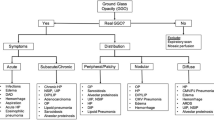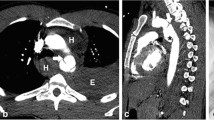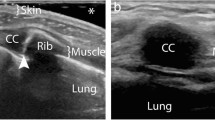Abstract
Bronchial foreign bodies (FB) in children are difficult to diagnose when there is no witness to the aspiration event. The experience with three-dimensional CT and virtual bronchoscopic reconstruction (3D-CTVB) was reviewed for the diagnosis of bronchial FB in pediatric patients in this study. A retrospective review of ten pediatric patients (M:F = 5:5) who underwent rigid bronchoscopy by one otolaryngologist for the impression of a bronchial FB, at a tertiary training hospital, from February 2006 to September 2010 is reported. All patients had a plain chest X-ray and 3D-CTVB. The physical, radiological and bronchoscopic findings of the patients were analyzed. The mean duration from the aspiration event to hospital evaluation was 7 days (0–21 days). Four patients (44%) had witnesses to the aspiration event. Hyperaeration of the affected lung was noted in nine patients (90%) on the plain chest X-ray. In all of the patients, the foreign body location, suspected on the preoperative 3D-CTVB, was consistent with the intra-operative bronchoscopic findings. All FBs were successfully removed by rigid bronchoscopy without any complications. In conclusion, the 3D-CTVB was a very safe and useful diagnostic modality for bronchial FBs. The findings of this study suggest that the 3D-CTVB should be considered for the diagnosis of all patients with suspected bronchial FBs.


Similar content being viewed by others
References
Cummings CW et al (2005) Otolaryngology, head and neck surgery, 4th edn. Elsevier Mosby, USA, pp 4343–4347
Reilly J, Thompson J, MacArthur C, Pransky S, Beste D, Smith M et al (1997) Pediatric aerodigestive foreign body injuries are complications related to timeless of diagnosis. Laryngoscope 107:17–19
Tomaske M, Gerber A, Stocker S, Weiss M (2006) Tracheobronchial foreign body aspiration in children—diagnostic value of symptoms and signs. Swiss Med Wkly 136:533–538
Barrios JE, Gutierrez C, Lluna J, Vila J, Poquet J, Ruiz S (1997) Bronchial foreign body: should bronchoscopy be performed in all patients with a choking crisis? Pediatr Surg Int 12:118–120
Svedstrom E, Puhakka H, Kero P (1989) How accurate is chest radiography in the diagnosis of tracheobronchial foreign bodies in children? Pediatr Radiol 19:520–522
Reilly J, Thompson J, MacArthur C, Pransky S, Beste D, Smith M et al (1997) Pediatric aerodigestive foreign body injuries are complications related to timeliness of diagnosis. Laryngoscope 107(1):17–20
Skoulakis CE, Doxas PG, Papadakis CE, Proimos E, Christodoulou P, Bizakis JG et al (2000) Bronchoscopy for foreign body removal in children. A review and analysis of 210 cases. Int J Pediatr Otorhinolaryngol 53:143–148
Hong SJ, Goo HW, MD, Roh JL (2008) Utility of spiral and cine CT scans in pediatric patients suspected of aspirating radiolucent foreign bodies. Otolaryngol Head Neck Surg 138:576–580
Haliloglu M, Ciftci AO, Oto A, Gumus B, Tanyel FC, Senock ME et al (2003) CT virtual bronchoscopy in the evaluation of children with suspected foreign body aspiration. Eur J Radiol 48:188–192
Adaletli I, Kurugoglu S, Ulus S, Ozer H, Elicevik M, Kantarci F et al (2007) Utilization of low-dose multidetector CT and virtual bronchoscopy in children with suspected foreign body aspiration. Pediatr Radiol 37:33–40
Bhat KV, Hegde JS, Nagalotimath US, Patil GC (2010) Evaluation of computed tomography virtual bronchoscopy in paediatric tracheobronchial foreign body aspiration. J Laryngol Otol 124:875–879
Yadav SPS, Singh J, Aggarwal N, Goel A (2007) Airway foreign body in children; experience of 132 cases. Singap Med J 48(9):850–853
Mallick MS, Khan AR, Al-Bassam A (2005) Late presentation of tracheobronchial foreign body aspiration in children. J Trop Pediatr 51:145–148
Zerella JT, Dimler M, McGill LC, Pippus KJ (1998) Foreign body aspiration in children: value of radiography and complications of bronchoscopy. J Pediatr Surg 33:1651–1654
Applegate KE, Dardinger JT, Lieber ML, Herts BR, Davros WJ, Obuchowski NA et al (2001) Spiral CT scanning technique in the detection of aspiration of LEGO foreign bodies. Pediatr Radiol 31:836–840
Brenner DJ, Hall EJ (2007) Computed tomography—an increasing source of radiation exposure. Engl J Med 357:2277–2284
Author information
Authors and Affiliations
Corresponding author
Rights and permissions
About this article
Cite this article
Jung, S.Y., Pae, S.Y., Chung, S.M. et al. Three-dimensional CT with virtual bronchoscopy: a useful modality for bronchial foreign bodies in pediatric patients. Eur Arch Otorhinolaryngol 269, 223–228 (2012). https://doi.org/10.1007/s00405-011-1567-1
Received:
Accepted:
Published:
Issue Date:
DOI: https://doi.org/10.1007/s00405-011-1567-1




